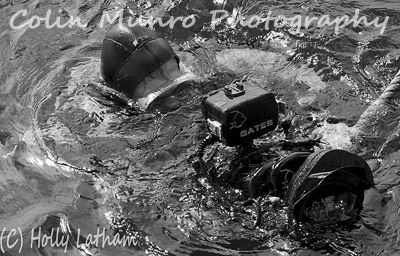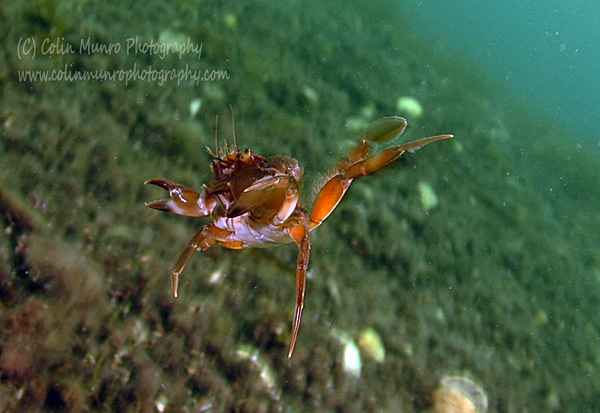All the images in this blog are available to license. To view a gallery (license images or purchase prints of) these, and more of my North east Atlantic marine invertebrate images go here. Alternatively you can search all my online stock images at my www.colinmunro.photoshelter.com site through the search box (top right) here or on my main website here. swimming crab images, Liocarcinus depurator images, necora puber images, stock images.
Flying crabs
A crab is neither the most graceful nor aerodynamic creature in the sea. Okay you probably knew that already. At first glance it does not appear to be designed for flight, its squat, angular body, entirely encased in a thick, heavy shell. A crab attempting to fly would seem as sensible as attempting to run a marathon wearing a suit of armour. But then, as anyone who has watched the London marathon will know, people do attempt – and succeeded – in running marathons in suits of armour. So why shouldn’t crabs fly?
I have been a little loose with the term ‘fly’; okay, they fly underwater. They are collectively known as swimming crabs. This group includes such species as the blue crab (Callinnectes sapidus) which is found around the coasts of North and South America, the red-eyed and fearless velvet swimming crab (Necora puber) that is common on shallow rocky reefs around the coast of UK and much of Europe, and the blue-legged swimming crab (Liocarcinus depurator) also common in shallow waters around UK and Europe but preferring sandier areas.

the distinctive wild red eyes and aggressive posture of a velver swimming crab (Necora puber). Note the broad swimmerets. Image No. MBI001256
A common feature of all these crabs is the adaptation of the fifth walking leg for propulsion through the water. Crab legs are mostly fairly spindly affairs, ending in points on which they tippy-toe across the sea bed. The final articulated segment of swimming crab legs is flattened and splayed into a paddle shape. Additionally they are edged with long thick hairs, effectively widening the paddle blade. These swimming legs are known as pleopods (from the Greek plein, to sail or to swim, and pods – legs) or swimmerets.
I started this by stating that crabs were not really designed to fly (or swim for that matter). This is true. Swimming marine creatures conjures up images of graceful fluid movements. That is not swimming crabs. Generally swimming crabs swim when disturbed, as a means of escaping real or perceived danger. They launch themselves off the seabed, flailing wildly as if convulsing through being wired up to high voltage electricity. For seconds, or at most a few minutes, the crab will move erratically through the water. As it tires its legs will slow; the crab will drift back down to the seabed, to scuttle away hopefully haven shaken off its pursuer.
Watching a crab frantically waving its legs in an attempt to defy gravity, as it descends inexorably back to solid seabed I am always struck by the uncanny resemblance to another quirky British tradition (apart from wearing ridiculous costumes for marathons) that of the birdman competition. This is an annual event held in several seaside towns, most notably Bognor Regis, where the great British eccentric emerges to don one-piece stripey swimsuits, circa 1900, batman masks, vinyl capes and wings that appear to be constructed from broom handles and ostrich feathers. Suitably attired they launch themselves off the end of the town jetty. Arms flaying wildly in an attempt to defy gravity (now you see where I’m coming from) they perform a graceless parabola and they too, descend inexorably to the sea below.
The first birdman competition (according to Wikipedia) occurred in Selsey, West Sussex, in 1971. How long have crabs been launching themselves off the seabed, attempting to escape the limitations imposed by a million years of evolution, no-one knows. Perhaps they have been sitting, half-buried, on the seabed, watching and pondering on ill-designed creatures in strange garb plunge in to the sea as they attempt to escape their own limitations. Perhaps flying crabs are a recent phenomenon, the dreamers inspired by eccentrics in sleepy seaside towns.


